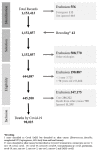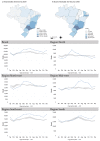Mortality and Years of Potential Life Lost Due to COVID-19 in Brazil
- PMID: 34300077
- PMCID: PMC8305074
- DOI: 10.3390/ijerph18147626
Mortality and Years of Potential Life Lost Due to COVID-19 in Brazil
Abstract
In November 2020, Brazil ranked third in the number of cases of coronavirus disease 2019 (COVID-19) and second in the number of deaths due to the disease. We carried out a descriptive study of deaths, mortality rate, years of potential life lost (YPLL) and excess mortality due to COVID-19, based on SARS-CoV-2 records in SIVEP-Gripe (Ministry of Health of Brazil) from 16 February 2020, to 1 January 2021. In this period, there were 98,025 deaths from COVID-19 in Brazil. Men accounted for 60.5% of the estimated 1.2 million YPLLs. High YPLL averages showed prematurity of deaths. The population aged 45-64 years (both sexes) represented more than 50% of all YPLLs. Risk factors were present in 69.5% of deaths, with heart disease, diabetes and obesity representing the most prevalent comorbidities in both sexes. Indigenous people had the lowest number of deaths and the highest average YPLL. However, in indigenous people, pregnant women and mothers had an average YPLL of over 35 years. The excess mortality for Brazil was estimated at 122,914 deaths (9.2%). The results show that the social impacts of YPLL due to COVID-19 are different depending on gender, race and risk factors. YPLL and excess mortality can be used to guide the prioritization of health interventions, such as prioritization of vaccination, lockdowns, or distribution of facial masks for the most vulnerable populations.
Keywords: COVID-19; excess mortality; years of potential life lost.
Conflict of interest statement
The authors declare no conflict of interest.
Figures






References
-
- Acter T., Uddin N., Das J., Akhter A., Choudhury T.R., Kim S. Evolution of severe acute respiratory syndrome coronavirus 2 (SARS-CoV-2) as coronavirus disease 2019 (COVID-19) pandemic: A global health emergency. Sci. Total Environ. 2020;730:138996. doi: 10.1016/j.scitotenv.2020.138996. - DOI - PMC - PubMed
-
- Mofijur M., Fattah I.M.R., Alam M.A., Islam A.B.M.S., Ong H.C., Rahman S.M.A., Najafi G., Ahmed S.F., Uddin M.A., Mahlia T.M.I. Impact of COVID-19 on the social, economic, environmental and energy domains: Lessons learnt from a global pandemic. Sustain. Prod. Consum. 2021;26:343–359. doi: 10.1016/j.spc.2020.10.016. - DOI - PMC - PubMed
MeSH terms
LinkOut - more resources
Full Text Sources
Medical
Miscellaneous

